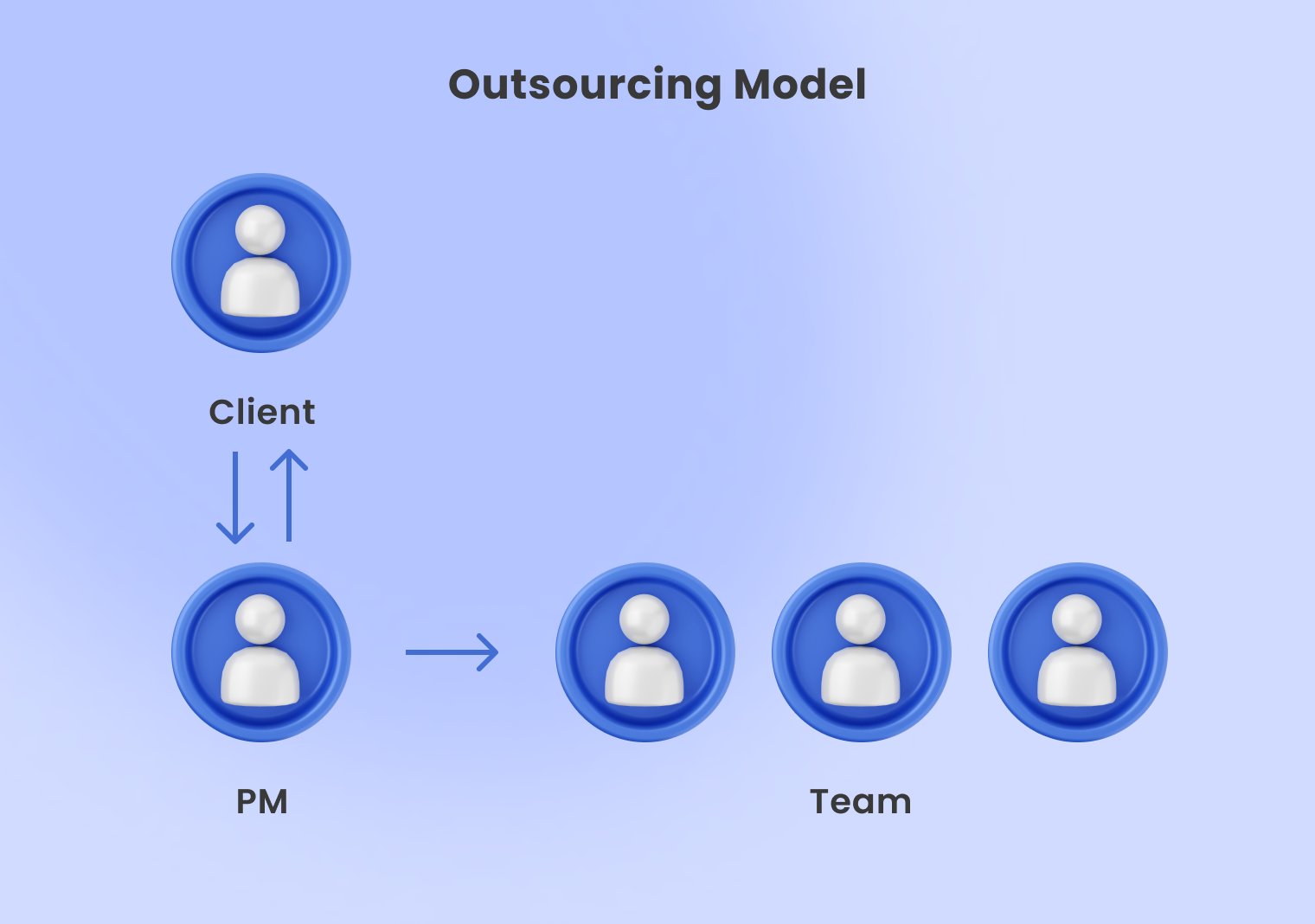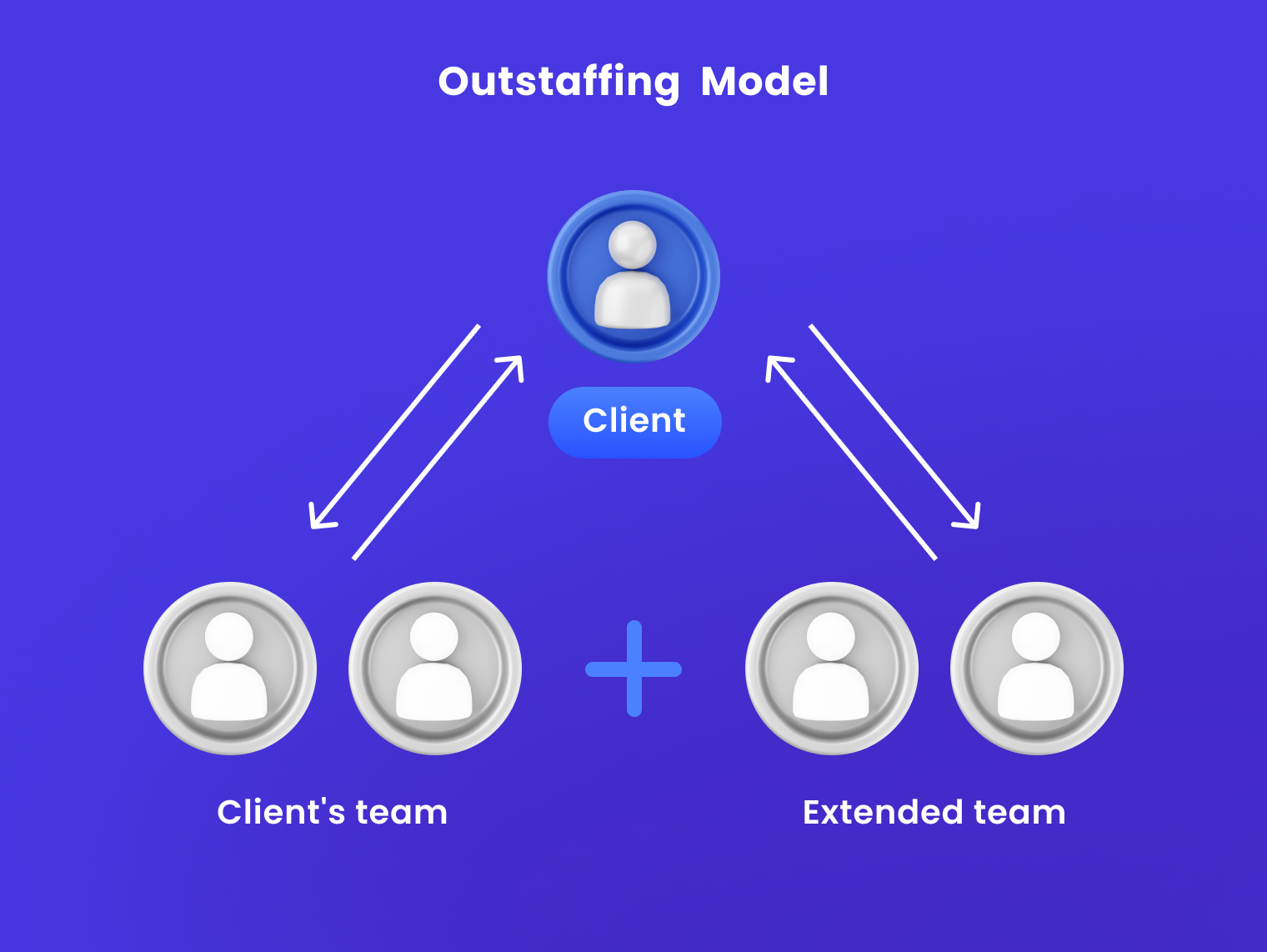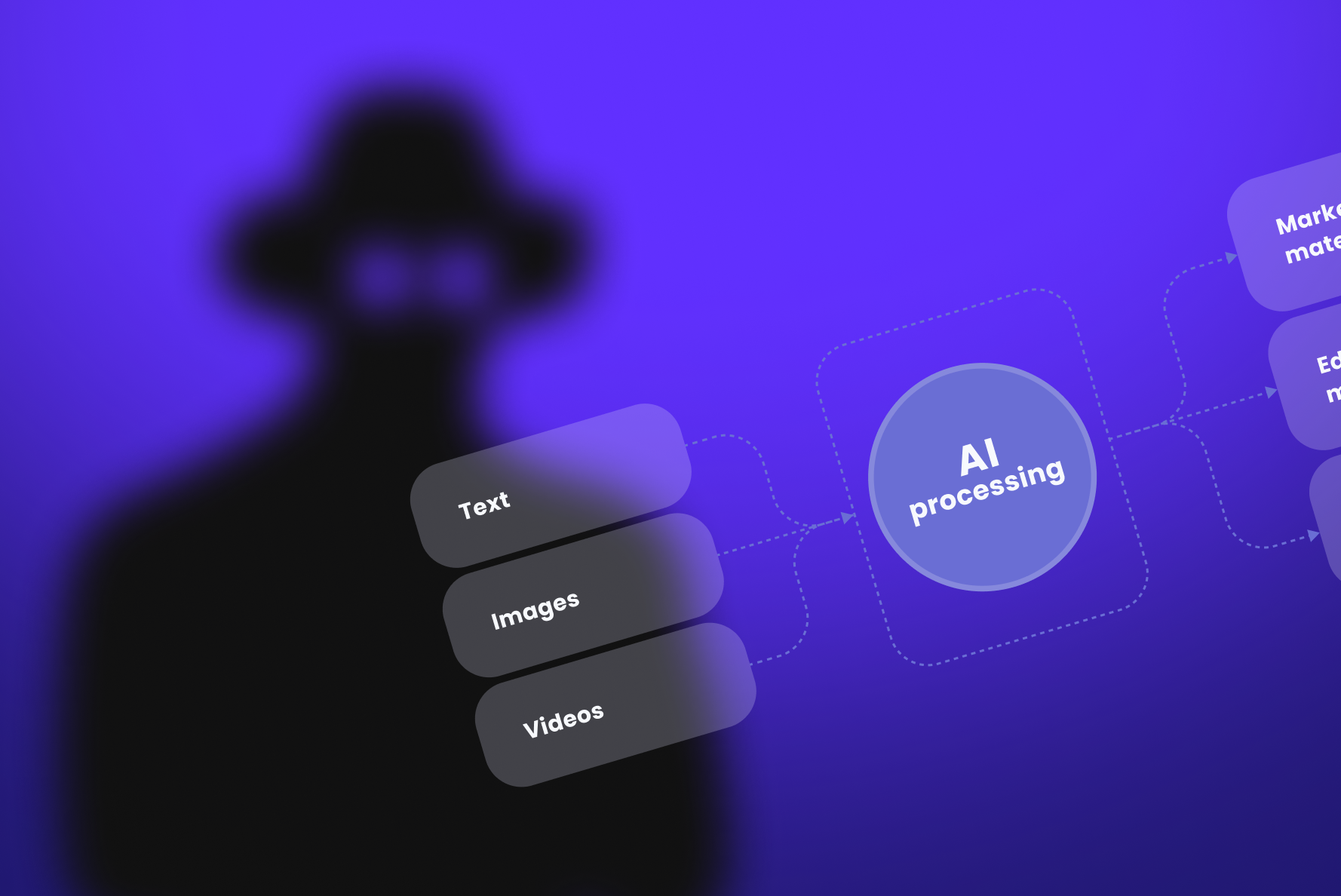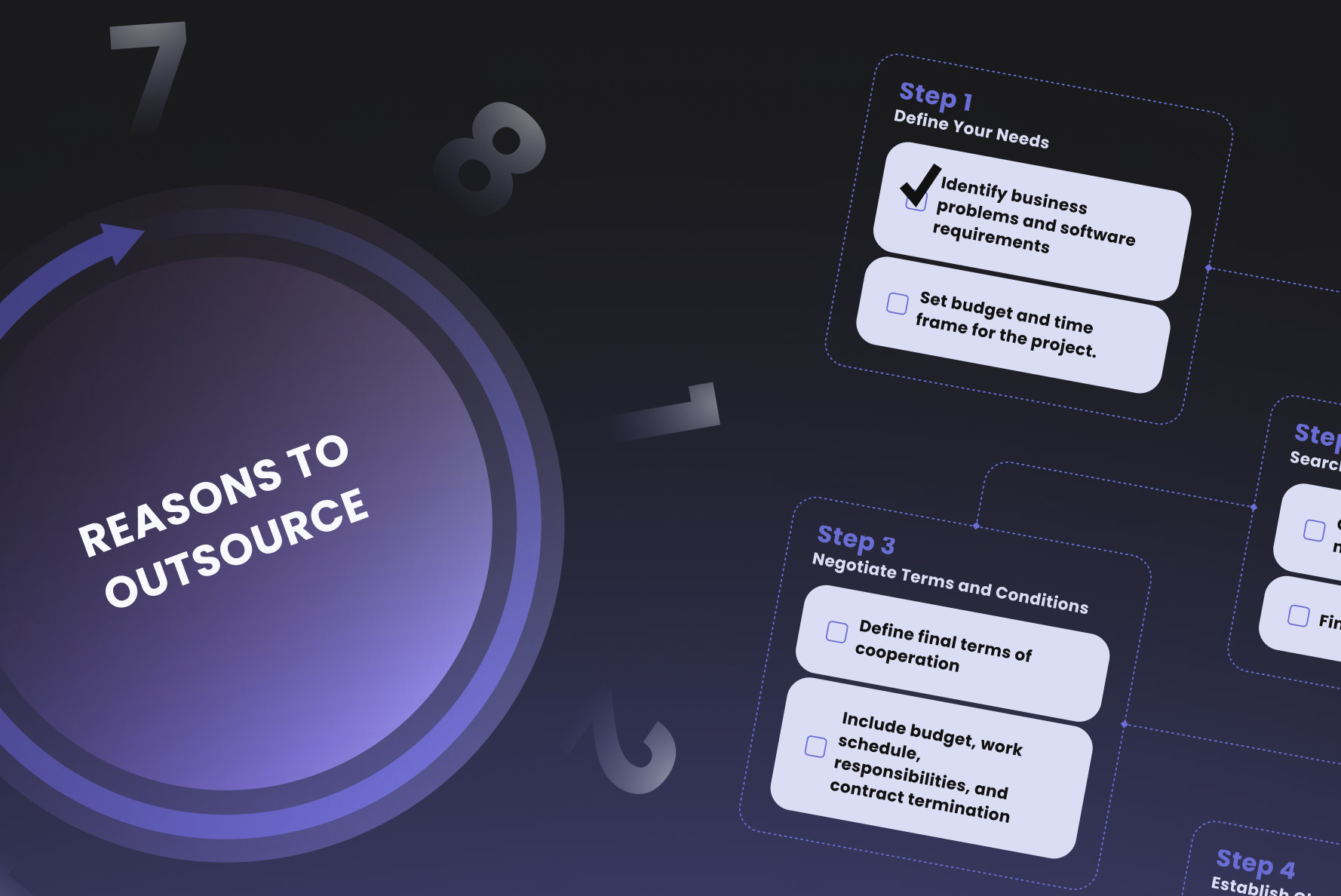Team augmentation, subcontracting, offshoring.
If you have searched for new engineering talents to do the work or fill the skill gap in your team, you’ve surely come across these terms in various locations. In a nutshell, they mean two most popular practices in the IT industry to attract engineers: software outsourcing and outstaffing. If you have a project on the way and lack tech specialists to do it, you should know the difference between them to follow the most suitable cooperation model.
Over a decade of providing top vendors with professional software engineers, UVIK has learned what to consider when choosing software development outsourcing vs outstaffing. This article focuses on the differences between the two, the advantages and disadvantages of each, and the factors that should affect your choice. Spoiler: there are a lot of them. So, let’s get straight to business! Outsourcing refers to a situation where a company enters into an agreement with another company to avail services or products that it could theoretically create in-house. On the flip side, outstaffing involves a scenario where a company enlists the services of employees from a different company to work on its behalf.
Difference between Outsourcing and Outstaffing
|
Outsourcing |
Outstaffing |
|
|
Outsourcing and staff augmentation in software development (outstaffing) mean different approaches to who and how will do a particular tech task. And before we explain this any further, we need to provide a few definitions of terms we’ll use throughout the article.
Client — a business that requests outsourcing or outstaffing services.
Outsourcing — a cooperation model where a client delegates the whole product development cycle or one of its stages to the outsourced team that usually does it remotely.
Outsourcing company/vendor — a business dealing with partial or full-cycle product development remotely.
Outstaffing (also, staff augmentation) — a cooperation model when a client hires developers from a tech vendor to work with the client’s in-house team.
Outstaffing company/vendor — a tech vendor company that searches, hires, and provides clients with various-skilled developers to work on clients’ projects with its in-house team.
Now we’re ready to explain the difference between software development outsourcing vs staff augmentation in more detail.
Outsourcing
In outsourcing, the client delegates full or partial product development to the outsourcing vendor’s team. In this case, the outsourcing company is responsible for hardware, materials, and other resources needed to complete the project and provide the clients with the set deliverables. Usually, this business model presupposes low control from the client’s side unless specified otherwise.
The outsourcing agency assigns a dedicated project manager that acts as an intermediary between the client and the developer. The client pays a fixed price per project as initially agreed and doesn’t have to worry about any hardware, environment setup, team composition, etc.
For example, a business startup may have a concept of a product that the healthcare providers might benefit from. If they don’t have an IT department to create this product, they can outsource its development to the tech agency that will deal with it end to end.
This cooperation model can be visualized like this:

Software Development Outstaffing
In an outstaffing model, the hired developers join the client’s team and work under the client’s supervision with the resources provided by clients. It means that the outstaffing vendor is responsible for providing a qualified specialist to the client, paying their salary, and doing all HR management. The client is responsible for the tasks, supervision, and control over the development process in which the outstaffed developer is involved.
In a nutshell, outstaffing means inviting people to the in-house team to cover the need for certain skills. For example, if the company works on a healthcare project but the team lacks cloud engineers or QA specialists, they can source the required specialist from the outstaffing agency.
Here’s a scheme of outstaffing cooperation:

The main difference between the outstaffing vs outsourcing model is now clear, but it’s also important to know the strengths and weaknesses of each practice.
Advantages and Disadvantages of Outsourcing
Outsourcing is a popular practice for businesses that don’t need a permanent full-stack team as it’s costly and not always necessary. And while this approach has its advantages, you should also be aware of its pitfalls. Let’s discuss them in more detail.
|
Advantages of Outsourcing |
Disadvantages of Outsourcing |
|
|
Advantages of Outsourcing
- Code quality is the outsourcing team’s responsibility. When you outsource the project development, you only have to provide a brief and guidelines of what you want to achieve as a result. This way, your company will deal only with business processes and investments, while the outsourcing team will take care of the product’s development.
- Software or hardware is provided by the outsourcing company. Hiring a developers team and equipping them with the necessary hardware and software might cost a pretty penny, and spending your budget on temporary needs is just money down the drain. If you choose software development outsourcing, you’ll save not only on hiring a permanent tech team but also on the equipment that you won’t need in a few months.
- Tech vendor manages the process. The good thing about outsourcing is that you’ll be assigned a dedicated project manager as your first point of contact. They will update you on your project progress, provide reports, arrange meetings with the team, and keep in touch throughout the development process for you to be in the know regarding budget spending, accomplished tasks, etc.
- The outsourcing company does all hiring and HR. The in-house hiring process may take around 66 days and will cost you more than average. Partnering with an outsourcing agency, you can have a developers team with the needed skills within a few hours. This way, you’ll start product development cycle earlier and launch the solution faster.
Alongside these advantages, you should also compare the disadvantages of outsourcing product development. Here are a few decisive factors.
Disadvantages of Outsourcing
It’s essential to know the drawbacks of each cooperation model during the outstaffing vs outsourcing discussion as it can save you from costly mistakes. Keep in mind these factors before hiring an outsourcing team:
- You won’t have much control over the resources and their quality. With outsourcing, you hire a team that uses certain infrastructure, tools, software, and hardware. And while you have the right to inquire about the team’s tech components and software, you don’t have much control over how the activities are carried out or how the resources are used. Plus, if at some point in the development process, you have to switch to specific technologies (because of law enforcement or other requirements), you’ll pay extra for the new tools.
- Limited participation in the process. While you may share the guides and ideas with the teams, the outsourcing companies’ contracts usually limit the client’s intervention in the development process. So when you need to deviate from something you’ve previously agreed to, you’ll most likely be charged extra.
- Reliability concerns. When you outsource development to remote teams, you rely on their expertise, skills, and work ethics, which, after you start working, may not match your expectations. One of the widespread concerns is that you will never know the developer’s level of expertise until you see the results of their work. For example, outsourcing agencies may provide you (and charge for!) with a team of senior engineers, but you will receive the results you’d expect from the junior developers. To avoid this scenario and ensure you hire professionals, you should ask for additional testing or an interview with the tech team, go through verified reviews, and contact businesses that have used outsourcing agency’ services. However, this process will cost you time. but be ready to spend extra time and costs.
- Higher cost compared to outstaffing. Outsource agencies have different pricing models, with hourly payment being the usual. It covers the management and development expenses, which is why it costs more than outstaffing as the latter doesn’t include management fees.
These drawbacks won’t affect the process if you partner with a reliable and professional agency that doesn’t try to overcharge you for mediocre services.
Here’s an example when outsourcing makes sense:
You’re an insurance company that requires a compliant customer relationship management (CRM) platform to manage your client’s data and process claims more effectively. However, your tech department is either too small or too busy to deal with end-to-end development. Naturally, you would like to have a compliant and reliable solution without spending valuable time on searching and hiring skilled and experienced developers. In this case, outsourcing development to a tech vendor is a time and cost-effective solution.
But what if you have a tech team that misses a specialist with certain skills? That’s when you may consider outstaffing. Let’s see its pros and cons and what difference it may bring to your business.
Advantages and Disadvantages of Outstaffing
You can augment your tech team by hiring a developer from an outstaffing agency and have a full team assembled to start your project. Here are its advantages and disadvantages at a glance.
|
Advantages of Outstaffing |
Disadvantages of Outstaffing |
|
|
Advantages of Outstaffing
- Lower cost compared to outsourcing. In outstaffing, you hire developers and pay a fixed rate depending on the price model without paying extra for the office, hardware, employee’s bonuses, or insurance.
- Flexible hiring. You hire only the specialists that your team lacks. The best part? You can onboard a new member in a few hours. You only have to ask the outstaffing agency to provide you with the CVs of the best-fit candidates and choose among them.
- Full control of the development process. The outstaff developers work under your supervision and report directly to you, so you have more control over the project management. Plus, you assign tasks and monitor the progress yourself, so you can intervene at any time and modify the development progress.
- On-demand access to resources and planning. You coordinate resources and their quality. You also plan your work and decide when it’s time to add or remove certain specialists. This cooperation model helps you save money as you augment your team only when needed.
- High delivery speed. When hiring an IT professional, they spend less time learning how to make their work compatible with your business as they’re already familiar with your processes. This is why you will maintain a high speed of delivery and will take the product to market faster.
- Reliability. Hiring developers from an outstaffing agency to complete your team gives you peace of mind that your work will be done on time and as expected. On the one hand, they have responsibilities before the outstaffing agency. On the other hand, they are responsible for their part in the client’s project. So if any developer is fired from the project, it will be a red flag for the outstaffing agency and a reason to fire them, too.
Alongside the peace of mind, lower costs, and full control, outstaffing has a few drawbacks to consider.
Disadvantages of Outstaffing
When you choose software development outstaffing, you should also know about its flipsides.
- Communication challenges. Communication is key when a part of your team works remotely. Unfortunately, it’s not always possible to maintain friction-free communication and get the team on the same page. In this case, the client should invest in secure platforms that would make transparent and timely communication possible.
- Client is fully responsible for the project outcomes. This can be a disadvantage if you don’t have expertise in developing the project you’ve hired a developer for. The hired employee may be an excellent pro in coding but might eventually hurt the development process if your team lacks QA expertise or effective management.
- Hidden costs. Overtime work or rate changes are usually covered by clients.
Example when outstaffing makes sense:
You’re a company that creates software. You’ve landed the client that needs one of the cloud solutions you’ve previously developed for them, and you don’t have cloud engineers on your team. In this case, you will augment your team with cloud developers. As a result, you’ll have team members familiar with the client’s IT infrastructure and the needed specialists who will jump into the development process right away.
Now that you know the outsourcing and outstaffing difference in software development, and their pros and cons, let’s discuss when they will be most beneficial for your company.
Outsource vs Outstaff Your Software Development Project: What Should You Choose?
Every project and business situation is different, but there are a few common cases when it’s better to outsource and when outstaffing would be more beneficial. Here’s what UVIK’s team thinks about it.
Outsourcing is a go-to option when:
- Your core product/service doesn’t include tech solutions
- You don’t have the budget to maintain a full-stack tech department
- You can’t afford undertaking another project because your tech team is already overwhelmed
- You don’t have prior expertise developing the product
Outstaffing is the best choice when:
- Your tech department lacks specialists with a specific skill set
- You don’t have the resources to go through a certain development phase (e.g., QA/QC testing or UX)
- You don’t want to deal with hiring/HR and need a specialist now
- You want to control and manage every development process
In each case, you should only partner with the tech vendors that have expertise in developing solutions for your industry, and are familiar with its requirements for software products. Here’s where the UVIK team can help.
Need Outstaffing Services? UVIK’s Got You Covered!
UVIK is an outstaffing company that’s been providing skilled developers for various projects for over a decade. Our specialists have worked in teams on solutions for legal, fintech, ecommerce, management, and other industries, so they quickly pick up the developing pace and maintain it.
At UVIK, you can hire specialists to do:
- Backend and frontend development in various languages (Python, Java, etc.)
- Cloud computing
- QA and QC
- AI, ML. AR, VR, IoT integration
- IT architecture
- Mobile app development, and other tasks.
Our flexible pricing models and carefully sourced pool of tech talents will help you supercharge your tech team with skilled professionals and develop a quality product on time. Contact our team and schedule a free consultation to see how our services can improve our project!











